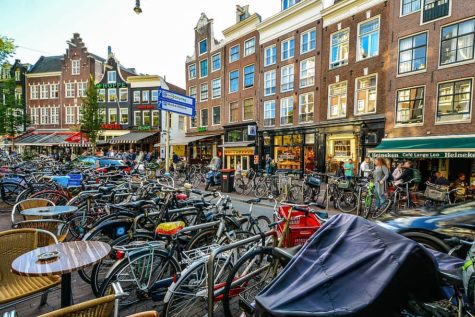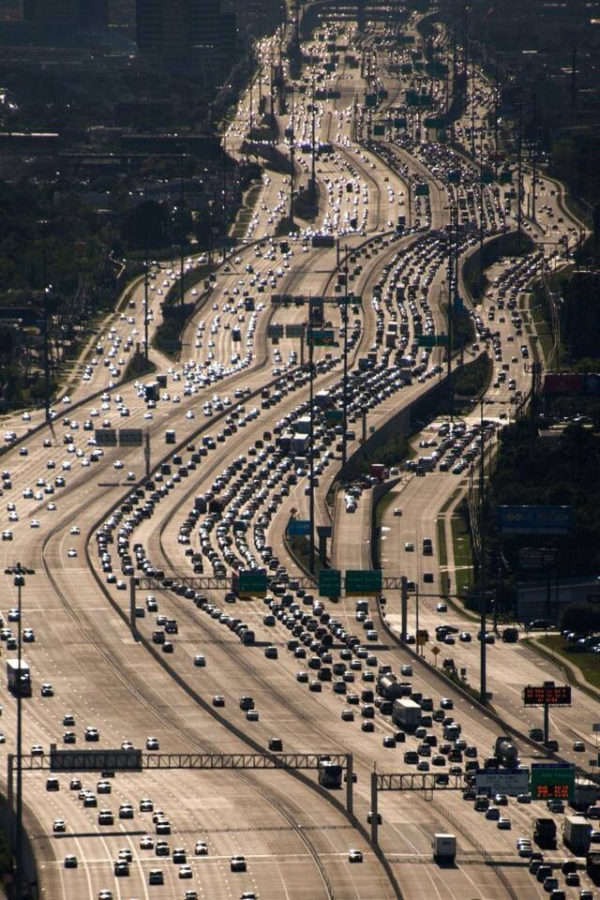America’s Car Problem
Cars are heralded as a hallmark of our society and of individual freedoms, but are they really deserving of this status? In fact, it’s quite the opposite.
Aliciak3yz, CC BY-SA 4.0
The philosophy of adding “just one more lane,” has led to abominations like the Katy Freeway, a 26 lane highway in Houston, Texas. And no, the extra lanes did not solve congestion.
Cars promote individual freedom. Or, at least, that’s what they’re supposed to do. Since the twentieth century, individually or family owned vehicles have become a core part of the American dream. From commuting to work to purchasing food, a large portion of the United States is forced to rely exclusively on motor vehicles to complete essential tasks, leading to adverse impacts on the environment, human lives, and communities that cannot be understated. The road to our current predicament was a long one, filled with destruction, racism, and lobbying, as once walkable cities were bulldozed into car centric wastelands.
History
After World War II, Americans had unprecedented wealth, soldiers came back and started families, and factories were freed to produce peacetime products. All of this newly found prosperity manifested itself in the immediate and graceful adoption of automobiles by everyone in the U.S. Or did it?
This was, in fact, very far from what happened. Streets were mixed use back then, meaning they hosted trolleys, horses, and pedestrians. The new massive and fast vehicles were a menace, disproportionally killing children. Legislation was even introduced to mandate that cars have speed governors, devices that regulate vehicles’ maximum speed. However, judging by our surroundings today, the automobile industry prevailed. Through government lobbying, the inherent lack of safety accompanying cars became the fault of pedestrians, with new crimes, such as jaywalking, being invented to limit the rights of pedestrians.
In addition, urban renewal projects prevailed during this time period. Led by individuals such as Robert Moses and William Levitt, this movement focused on their vision for improving cities, which catered towards middle class white families and discriminated against minorities. For example, the Cross Bronx Expressway, pushed for and created by Moses, split the Bronx in two, displacing thousands of people. This development has had long term negative effects on locals, plummeting air quality and property values.
A critical dependence on cars for transportation has also led America to depend heavily on oil imports. This means conflict, and lots of it. With energy being an endlessly valuable resource, international conflicts can be frequently explained in terms of fossil fuels. In fact, at least one out of every four wars between countries in the past fifty years have been caused by oil.
The Impact on Individuals
The negative effects of car dependency on the individual or family cannot be understated. Most notably, the cost to enter, in the form of buying and maintaining a car, means that poverty bars people from participating in society in the same way as their peers. This, on top of the fact that most American cities and suburbs are built without regard to other transportation methods, means that transportation is yet another hurdle to overcome.
In addition, for those who do not drive because they prefer not to or are below the minimum age for a license, homogenous car culture represents a barrier to independence. Gil Friedman ’24 address this point. “Ideally I would only use public transportation [for] both economic and environmental reasons, but due to the lacking public transit system outside of New York City, private vehicles are often a necessity,” Friedman said. New York City has one of the best public transportation systems in the country, which is a major advantage to its residents. However, in the rest of the United States, people do not have this freedom, and they are forced to conform to a pervasive car culture.
Just One More Lane
In December 2016, Elon Musk, the controversial billionaire and CEO of Tesla, SpaceX, and Twitter, among other job titles, announced his dissatisfaction with traffic over Twitter, stating, “Traffic is driving me nuts.” This was the prelude to his creation of The Boring Company, which accomplished the construction of a single lane tunnel under Las Vegas. This, however, is a microcosm of everything that is wrong with modern car culture and efforts to improve current issues.
Induced demand, in the context of urban planning, is the concept that increasing capacity of transportation systems will increase the number of people who use them. For traffic, this means more roads will only bring temporary improvements, causing more people to drive, and therefore more traffic, in the long term. In this context, Musk’s seemingly visionary idea of bringing vehicles underground reveals its true nature, a publicity stunt that will accomplish absolutely nothing. In addition, these tunnels contain Tesla cars, rather than trains.
Musk has a history of animosity towards public transportation, once describing it as “painful.” An example of this is the hyperloop, an interesting vacuum based train that he remains a frequent proponent of. While there is nothing wrong with the science fiction concept of a hyperloop, Elon Musk proposed his pet project in an attempt to block development on high speed rail in California. The incentives here are simple, as the owner of a supposedly forward thinking and environmentalist car company realizes that better solutions, in the form of public transit, cut into his bottom line.
Environment
As previously mentioned, cars as a method of transportation are deplorably inefficient. According to data from the Transformative Urban Mobility Initiative, for every lane and hour in a city setting, mixed traffic will move up to 2,000 passengers, less than half of every alternative. Assuming no traffic, cars can be a fast method of transportation for individuals or families. However, buses, cyclists, pedestrians, and rail all boast significant advantages over vehicles in terms of number of people transported per hour, a far more important statistic for measuring efficiency. One way to envision this is to imagine a road of cars, but to replace every car with a person. Do you notice how sparse this road now looks? That is due to cars putting few people into large, individually coordinated and propelled, vehicles.
Climate change is becoming an ever more dire issue, as the United States is rated as “insufficient” in achieving under 2 degrees of warming globally, a benchmark for disaster. One of the primary causes of such high emissions is transportation, which makes up 29% of the nation’s carbon emissions.
Alternatives
One very tempting solution to the environmental issues posed by cars is a switch to electric vehicles. And, while EVs are often touted as the future by the car companies making them, they don’t even begin to fix the social issues associated with car culture and dependence. In addition, the large batteries required for these vehicles consist of rare Earth metals, including lithium, nickel, and cobalt. Extracting these very metals, which are limited in quantity and very concentrated in specific countries, does significant harm to the environment. In addition, the United States gets over half of its electricity from non-renewable sources, which means that the environmental impact of an electric vehicle is heavily dependent on where it is charged.
Replacing existing cars with their electric counterparts preserves the status quo, with efficient and dangerous vehicles being a prerequisite for participation in society. However, it doesn’t have to be this way. Imagine a more efficient method of transportation. For maximum efficiency, cars would ideally be linked together and powered by a single engine. Maybe these cars would even run on rail to increase safety and efficiency. And maybe, just maybe, they would be called something else, like a “train.” If properly invested in, they could replace road systems as the primary method of individual transportation, while also making it safer, faster, and cheaper for citizens. Inconveniences caused by not directly going between any two locations would be offset by the lack of traffic and parking. Doesn’t this sound great?

In addition to trains and subways for long distances, bicycles are also an amazing option for short range transportation. While cars are clunky and can make traveling short distances more of an ordeal than walking, cycling is a clean, fast, and cost effective way to get around. In addition, any able person can ride a bicycle or electric bike, including children and the elderly. This would give both groups much more independence that they are currently deprived of, due to safety risks posed by both driving and being around cars.
On the individual and family level, living in a society dependent on cars is detrimental to life and liberty. The majority of the United States lives in suburbia, where, in order to move from place to place, one must take a car. It is such an ingrained assumption that people will drive everywhere that urban and suburban areas are organized around the cars instead of the people that inhabit them. Car dependence is a fundamental problem that we must address as a society.
On the individual and family level, living in a society dependent on cars is detrimental to life and liberty.
Asa Paparo is the Student Director of Internet Technology for the Bronx Science Yearbook Observatory, as well as a Chief Graphic Designer and Academics...

